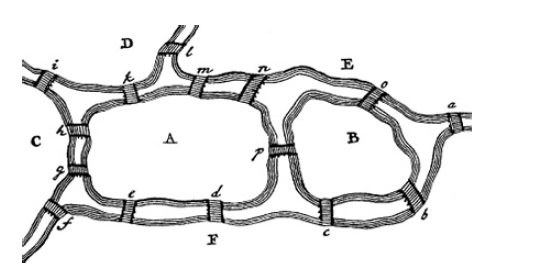
Concept explainers
This exercise comes to you courtesy of Euler himself. Here is the question in Euler's own words,
accompanied by the diagram shown in Fig. 5-63.
Let us take an example of two islands with four rivers forming the surrounding water. There are fifteen bridges marked a, b, c, d, etc., across the water around the islands and the adjoining rivers. The question is whether a journey can be arranged that will pass over all the bridges but not over any of them more than once.

Figure 5-63
What is the answer to Euler's question? If the “journey” is possible, describe it. If it isn't, explain why not.
Want to see the full answer?
Check out a sample textbook solution
Chapter 5 Solutions
Excursions In Modern Mathematics, 9th Edition
Additional Math Textbook Solutions
Pathways To Math Literacy (looseleaf)
College Algebra (7th Edition)
Introductory Statistics
Elementary Statistics: Picturing the World (7th Edition)
Finite Mathematics for Business, Economics, Life Sciences and Social Sciences
Elementary Statistics (13th Edition)
- I've been struggling with this because of how close the numbers are together!! I would really appreciate if someone could help me❤️arrow_forwardWhy charts,graphs,table??? difference between regression and correlation analysis.arrow_forwardMatrix MЄ R4×4, as specified below, is an orthogonal matrix - thus, it fulfills MTM = I. M (ELES),- m2,1. We know also that all the six unknowns mr,c are non-negative with the exception of Your first task is to find the values of all the six unknowns. Think first, which of the mr,c you should find first. Next, consider a vector v = (-6, 0, 0, 8) T. What's the length of v, i.e., |v|? Using M as transformation matrix, map v onto w by w = Mv provide w with its numeric values. What's the length of w, especially when comparing it to the length of v? Finally, consider another vector p = ( 0, 0, 8, 6) T. What's the angle between v (from above) and p? Using M as transformation matrix, map p onto q by q = Mp - provide q with its numeric values. What's the angle between w and q, especially when comparing it to the angle between v and p?arrow_forward
- (c) Find the harmonic function on the annular region Q = {1 < r < 2} satisfying the boundary conditions given by U (1, 0) = 1, U(2, 0) 1+15 sin (20). =arrow_forwardQuestion 3 (a) Find the principal part of the PDE AU + UÃ + U₁ + x + y = 0 and determine whether it's hyperbolic, elliptic or parabolic. (b) Prove that if U(r, 0) solves the Laplace equation in R², then so is V(r, 0) = U (², −0). (c) Find the harmonic function on the annular region = {1 < r < 2} satisfying the boundary conditions given by U(1, 0) = 1, U(2, 0) = 1 + 15 sin(20). [5] [7] [8]arrow_forwardNo chatgpt pls will upvote Already got wrong chatgpt answer Plz .arrow_forward
- 7. (a) (i) Express y=-x²-7x-15 in the form y = −(x+p)²+q. (ii) Hence, sketch the graph of y=-x²-7x-15. (b) (i) Express y = x² - 3x + 4 in the form y = (x − p)²+q. (ii) Hence, sketch the graph of y = x² - 3x + 4. 28 CHAPTER 1arrow_forward- (c) Suppose V is a solution to the PDE V₁ – V× = 0 and W is a solution to the PDE W₁+2Wx = 0. (i) Prove that both V and W are solutions to the following 2nd order PDE Utt Utx2Uxx = 0. (ii) Find the general solutions to the 2nd order PDE (1) from part c(i). (1)arrow_forwardSolve the following inhomogeneous wave equation with initial data. Utt-Uxx = 2, x = R U(x, 0) = 0 Ut(x, 0): = COS Xarrow_forward
- Could you please solve this question on a note book. please dont use AI because this is the third time i upload it and they send an AI answer. If you cant solve handwritten dont use the question send it back. Thank you.arrow_forward(a) Write down the general solutions for the wave equation Utt - Uxx = 0. (b) Solve the following Goursat problem Utt-Uxx = 0, x = R Ux-t=0 = 4x2 Ux+t=0 = 0 (c) Describe the domain of influence and domain of dependence for wave equations. (d) Solve the following inhomogeneous wave equation with initial data. Utt - Uxx = 2, x ЄR U(x, 0) = 0 Ut(x, 0) = COS Xarrow_forwardQuestion 3 (a) Find the principal part of the PDE AU + Ux +U₁ + x + y = 0 and determine whether it's hyperbolic, elliptic or parabolic. (b) Prove that if U (r, 0) solves the Laplace equation in R2, then so is V (r, 0) = U (², −0). (c) Find the harmonic function on the annular region 2 = {1 < r < 2} satisfying the boundary conditions given by U(1, 0) = 1, U(2, 0) = 1 + 15 sin(20).arrow_forward
 Elementary Geometry For College Students, 7eGeometryISBN:9781337614085Author:Alexander, Daniel C.; Koeberlein, Geralyn M.Publisher:Cengage,
Elementary Geometry For College Students, 7eGeometryISBN:9781337614085Author:Alexander, Daniel C.; Koeberlein, Geralyn M.Publisher:Cengage, Trigonometry (MindTap Course List)TrigonometryISBN:9781305652224Author:Charles P. McKeague, Mark D. TurnerPublisher:Cengage Learning
Trigonometry (MindTap Course List)TrigonometryISBN:9781305652224Author:Charles P. McKeague, Mark D. TurnerPublisher:Cengage Learning Elementary Geometry for College StudentsGeometryISBN:9781285195698Author:Daniel C. Alexander, Geralyn M. KoeberleinPublisher:Cengage Learning
Elementary Geometry for College StudentsGeometryISBN:9781285195698Author:Daniel C. Alexander, Geralyn M. KoeberleinPublisher:Cengage Learning Algebra: Structure And Method, Book 1AlgebraISBN:9780395977224Author:Richard G. Brown, Mary P. Dolciani, Robert H. Sorgenfrey, William L. ColePublisher:McDougal Littell
Algebra: Structure And Method, Book 1AlgebraISBN:9780395977224Author:Richard G. Brown, Mary P. Dolciani, Robert H. Sorgenfrey, William L. ColePublisher:McDougal Littell Mathematics For Machine TechnologyAdvanced MathISBN:9781337798310Author:Peterson, John.Publisher:Cengage Learning,
Mathematics For Machine TechnologyAdvanced MathISBN:9781337798310Author:Peterson, John.Publisher:Cengage Learning, College Algebra (MindTap Course List)AlgebraISBN:9781305652231Author:R. David Gustafson, Jeff HughesPublisher:Cengage Learning
College Algebra (MindTap Course List)AlgebraISBN:9781305652231Author:R. David Gustafson, Jeff HughesPublisher:Cengage Learning





